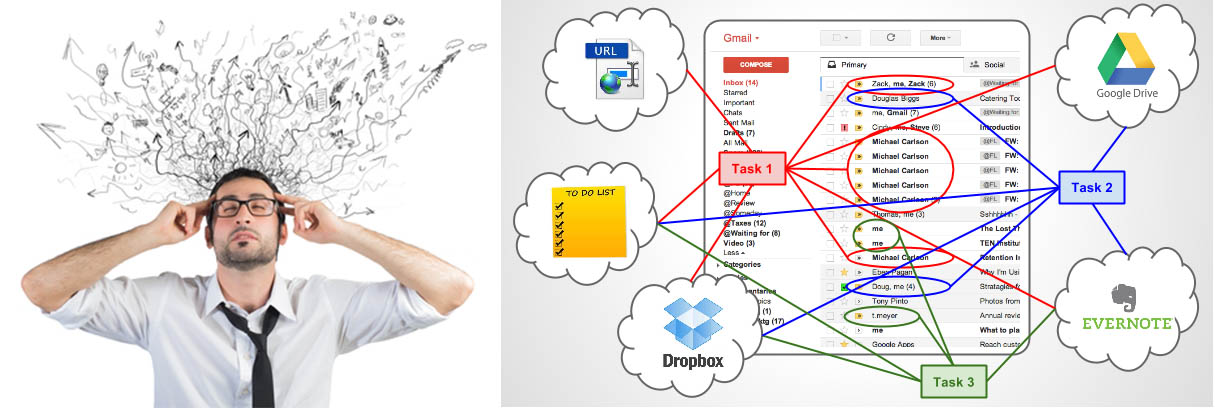One complex task can have hundreds of digital sub-tasks scattered across various devices, applications and clouds. Wouldn’t it be nice if there was a new tool that could seamlessly link these pieces together within one platform?
With the development of high speed internet, we’ve opened the door to increasingly practical and widespread use of cloud-based systems. These systems add convenience by allowing access to all of our databases through multiple devices, including tablets and mobile phones.
The next step in this evolution was the emergence of cloud-based applications like Gmail, Google Docs, Dropbox, Evernote, and many others, creating a much “easier” digital life, at least in concept.
The increase in the number of services we use has exponentially increased the number of locations where our information is stored. As a result, a single task has the potential to become scattered in:
- Multiple email messages buried in an already-overflowing inbox
- Different cloud services across the web
- Incompatible proprietary formats that don’t interact well
As such, multi-faceted, complex tasks can create one big data conundrum – one that continues to grow, creating a rubble of digital information with no logical connection between them. This lack of connectedness diminishes the convenience of having access to multiple applications and devices.
How Have We Coped with this Challenge to Date?
To tackle this fragmentation, many of us have tried different approaches – some more efficient than others.
First, we tried relying on memory.
We quickly realized that many tasks are too complex to manage relying on our memory. Not only do we need to remember the task itself, but we also need to bear in mind all the multiple sub-tasks, and how they relate to one another. As the number of connecting digital pieces continued to grow, our brains started to reach their limits. (Science tells us that our brains are only capable of remembering a maximum of seven related items at one time.)
Then we complemented our memory with search.
As the number of our files and tasks grew, we tried to manage long lists using the search functions provided by our programs and applications. Searching allowed us to quickly find specific files hidden among the piles of digital rubble – including endless lists of directories and folders. But once again, we were faced with limits. Search tools could only help us if we could remember what we had to do. Hence, search became an extension of – not a replacement for – memory.
We also tried using manually curated “To-Do” lists.
In an effort to increase our ability to deal with complex tasks that were too unwieldy for memory, many of us began to rely on task management applications that served as manually curated “To-Do” lists. However, most of the time, these applications weren’t designed to maintain the connections and relationships between tasks and related items; rather, they simply served as reminders that often became yet another chore to manage. Our “To-Do” lists required us to manually organize files, emails and other items in order to connect all materials related to the task at hand.
Still, we are left with digital clutter.
While neither memory, search tools nor manually curated “To-Do” lists are ideal solutions, we’ve learned to accept them as status quo, and a reality of working in the Information Age. But they remain inadequate solutions because they rely on memory and manual data entry.
As our tasks continue to grow in complexity, they require increased numbers of organized, logical connections. If you’ve ever found yourself confused about where you left off when working on a project – having to recollect all relevant files, documents and emails – then you are familiar with the frustrations that can result from “digital clutter.”
Somehow, our critical task-related information gets lost when we need it the most. Digital clutter can lead to increased stress, and, in some cases, panic. We dread working on a project when we know it’s going to create anxiety, which often leads to procrastination. And the spiral of frustration and tension continues, creating a hiccup in our workflow, a waste of productive work time, and a drain on our energy. Clearly, expending more time and energy on managing the pieces of complex tasks detracts from our efficiency!
How to Manage Your Growing Task Lists – and Maintain Peace of Mind
There are literally hundreds of productivity apps available in the marketplace, with new ones becoming available daily. These apps attempt to alleviate the challenges associated with “To-Do” lists and task management. Fierce competition in this space proves the need for a solution to this very real and tangible problem.
The fact that no clear winner has emerged in this field shows that the code to managing scattered tasks and digital information has yet to be cracked. In fact, most of these apps are creating yet another incompatible component. The result: an even bigger problem rather than a solution.
We know that there is a need for a new way of thinking – a paradigm shift, so to speak – that will provide a simple and flexible solution that will empower us to exponentially increase the efficiency of managing our complex tasks with little or no initial overhead.
The time has come to introduce a new application category: a Task Operating System designed to harness the full power of technology in order to scale our ability to deal with complex tasks, ultimately leading to greater efficiency and peace of mind.

